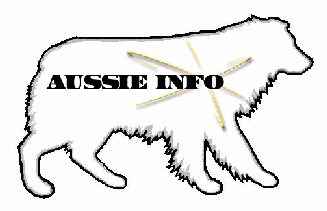
When finished reading any article on this site, please use your "back" button on your browser to return to the main topic pages.
What is the Australian Shepherd?
by Terry Martin, Slash V Working Australian Shepherds, beginning paragraphs of article printed in the Ranch Dog Trainer Magazine 1994
What kind of a working dog is an Australian Shepherd? What should we expect
of a good one? The Australian Shepherd is a "hands on" type of worker who
wants to be part of the action. He works close to the stock in an upright
position controlling his stock by gaining authority with confidence readily
backed up by grip. Different working situations have prompted breeders to
develop more variations in style than some breeds. Lines have been selected
to be heeling driving dogs, and this instinct may dilute the desire to head
and to contain the stock. Others are very strong fetch dogs with an intense
instinct to gather and keep the stock together. Understanding the style and
instinct of your individual dog is the first step to using him effectively.
Variation in style of the good dogs is the result of breeding for specific
needs. Variation in style of weak or inferior dogs in any breed is the
result of indiscriminate breeding or the unfortunate unpredictability of
hereditary traits. I can't overemphasize the importance of researching
bloodlines and talking to people who have actually seen the dogs work.
A good Australian Shepherd will work silent or use bark for authority. A
dog who barks and does not bite is of little use for ranch work. The ideal
Australian Shepherd will heel low and grip on the nose or face of cattle. A
good dog will instinctively run to the head of cattle needing to be turned
back and will apply force. The dog will have the confidence to walk in on
standing stock to move them. There are dogs who will effectively turn
running stock but will not use force on stock when standing. In many ranch
situations this dog is still useful because power is needed when stock are
running out of the handler's control. The dog should be there to help.
Just as you can use a man, horse, or a four wheeler, the dog has things he
can do for you. An Australian Shepherd's power, agility and stock savvy
give him an advantage over stock that none of the above can equal. The good
Australian Shepherd is always eager for physical confrontation with the
stock.
It is important to understand that the aggressive Australian shepherd is not
necessarily going to develop into a dog always biting stock. A good dog
will learn through experience and training when to apply force and when his
presence is sufficient to move or stop livestock. His early instinct to
bite livestock will develop into an awareness of appropriate force as he
learns about livestock's response to his actions. A confident aggressive
dog will convey his power to livestock in ways we probably will never
completely understand. You will see powerful dogs make a move toward a cow,
turning her without even touching her. The same cow will run over a weaker
dog in the same situation. Livestock can read a dog and sense their
weakness or strength. The dog with the grip to back up his stand has
learned he can hold his own and handle situations. This confidence is seen
as power by the stock. The dog who has been backed down by livestock will
be the loser too many times, and without confidence he becomes useless.
An important difference in working a dog like the Australian Shepherd
compared to a strong eyed breed is for you to understand where the dog is
comfortable working. This is where his instinct is going to put him. As a
comparison, imagine that the strong eyed dog is working an invisible circle
drawn out around the stock. As long as he can put pressure on one side of
that circle and the stock responds properly, he is content to stay outside
the circle. His constant eye contact tells him he is in control. Only when
the stock does not move from this subtle pressure does he move inside the
circle to apply needed force. The reason some "eye dogs" are considered
weak on aggressive stock is because of their reluctance to move inside this
circle when force is needed. The Australian Shepherd does not see this
invisible circle. He is working the stock themselves, and therefore his
instinct brings him closer before he is content that he has control. A good
Australian Shepherd will be aware of all the stock within his vision and
quickly correct one getting away or lagging while all the time his instinct
keeps him in close. This basic instinct to be close is one of the reasons
the breed is likely to grip or be aggressive. Near proximity triggers the
instinct to take hold.
The quiet courageous cattle dog who can handle tough cattle by gaining their
respect with grip and the sheep dog with the instinct to work wide off the
stock both use POWER and CONFIDENCE to be the best at what they do. But to
be truly great they must use it in far different ways.